Blending your own herbal tea infusions lets you create unique, personalized flavors while harnessing the potential health benefits of various herbs. Start with quality ingredients and essential tools like a digital scale and airtight containers. Choose a base herb, then experiment with complementary flavors and aromas to craft your signature blend. Pay attention to proportions, using about 1-2 grams of herbs per cup of water. Steep your creation at the right temperature and time for ideal flavor. Don't forget to store your blends properly to maintain freshness. With practice and creativity, you'll soon be brewing your own custom herbal tea masterpieces.
Understanding Herbal Tea Basics
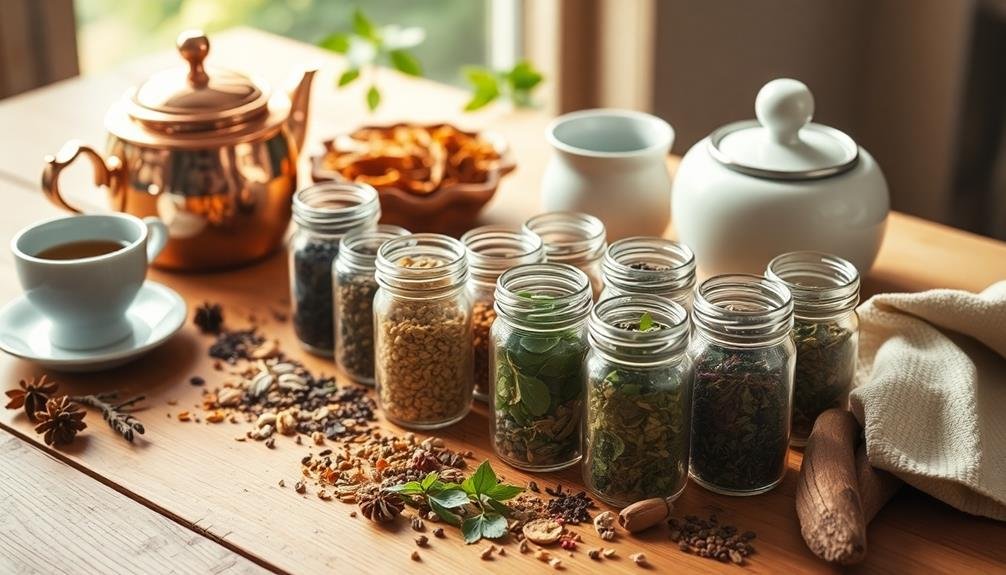
At its core, herbal tea isn't technically tea at all. Unlike traditional teas derived from the Camellia sinensis plant, herbal teas are infusions made from various herbs, spices, fruits, and botanicals. These caffeine-free beverages offer a wide range of flavors and potential health benefits.
To create your own herbal tea blends, you'll need to understand the basic components. Start with a base herb, which forms the primary flavor profile. Popular choices include chamomile, peppermint, or rooibos.
Next, add complementary herbs or spices to enhance the taste and aroma. Reflect on using ingredients like ginger, cinnamon, or lavender.
Finally, include accent ingredients for depth and complexity, such as rose petals or citrus peels.
When blending, remember that some herbs have stronger flavors than others. Start with small amounts and adjust to taste.
It's also important to reflect on the therapeutic properties of each ingredient. Many herbs offer potential health benefits, from promoting relaxation to supporting digestion.
Always research the safety and potential interactions of herbs before using them in your blends, especially if you have any health conditions or are taking medications.
Essential Tools for Tea Blending
A well-equipped tea blending station is vital for creating delicious herbal infusions. You'll need a few key tools to get started. First, invest in a quality set of measuring spoons and a digital scale for precise ingredient portions. A mortar and pestle are useful for crushing herbs and spices, releasing their flavors and aromas.
Storage containers are important for keeping your ingredients fresh and organized. Opt for airtight glass jars or tins to protect your herbs from moisture and light. Don't forget labels to keep track of your blends and expiration dates.
You'll also need tools for steeping and straining your teas. A mesh tea ball or reusable cloth tea bags are perfect for single servings, while a large tea infuser works well for bigger batches. A fine-mesh strainer is handy for loose leaf blends.
To enhance your blending experience, consider adding a tea journal to record your recipes and tasting notes. A timer guarantees consistent steep times, and a thermometer helps you achieve the ideal water temperature for different herbs.
With these essential tools, you'll be well-prepared to create your signature herbal tea infusions.
Selecting Quality Herbs and Ingredients
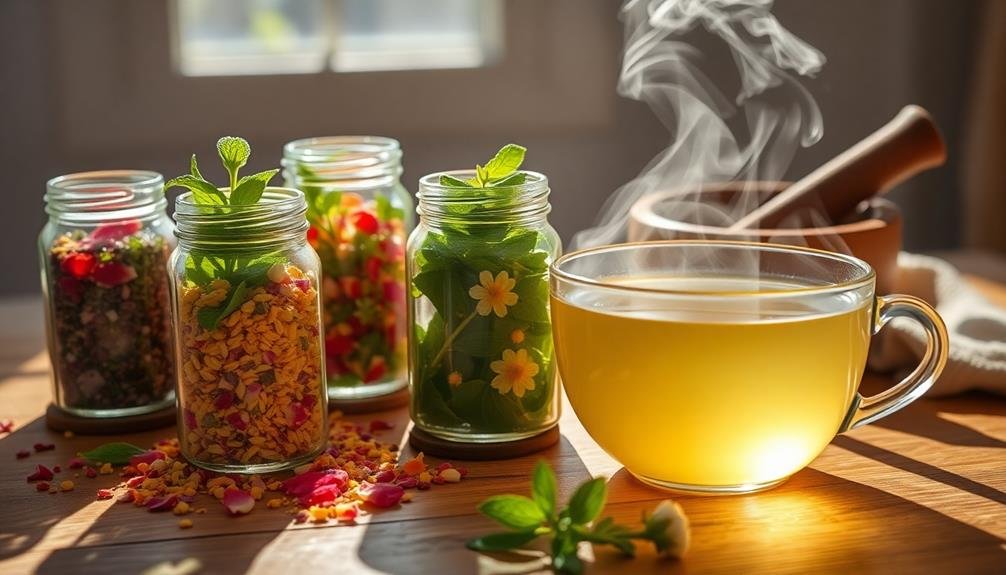
Choosing high-quality herbs and ingredients is essential for creating delicious and effective herbal tea infusions. You'll want to source your herbs from reputable suppliers who prioritize freshness and purity. Look for organic options whenever possible to avoid pesticides and other contaminants.
When selecting herbs, pay attention to their appearance, aroma, and texture. Fresh herbs should have vibrant colors and a strong, pleasant scent. Dried herbs should be crisp and retain their natural hue. Avoid herbs that appear dull, discolored, or have a musty odor.
Consider the following table for guidance on selecting quality ingredients:
| Herb Type | Visual Cues | Aroma | Texture |
|---|---|---|---|
| Leaves | Vibrant color | Strong, fresh | Crisp, not crumbly |
| Flowers | Bright petals | Fragrant | Delicate, intact |
| Roots | Even color | Earthy | Firm, not spongy |
| Berries | Plump, uniform | Sweet or tart | Dry, not sticky |
Remember to store your herbs properly in airtight containers away from light and heat. This will help preserve their potency and flavor. By carefully selecting and maintaining your ingredients, you'll guarantee that your herbal tea infusions are of the highest quality and effectiveness.
Balancing Flavors and Aromas
Creating a well-balanced herbal tea infusion is an art that combines flavors and aromas to produce a harmonious blend. To achieve this balance, you'll need to take into account the taste profiles of your chosen herbs and how they interact with one another.
Start by identifying the primary flavor you want to highlight, then build around it with complementary or contrasting notes.
Take into account the five basic taste sensations: sweet, sour, salty, bitter, and umami. Aim to incorporate a mix of these tastes in your blend for a more complex and satisfying infusion. For example, you might pair the sweetness of chamomile with the tartness of hibiscus or the earthiness of rooibos with the spiciness of ginger.
Don't forget about aromatics, which play a significant role in the overall experience of your tea. Herbs like lavender, mint, and lemon balm can add enticing scents that enhance the flavor profile.
As you experiment, keep track of your ingredient ratios and steeping times to fine-tune your blend. Remember that some herbs are more potent than others, so adjust quantities accordingly to prevent any single flavor from overpowering the others.
Creating a Flavor Profile
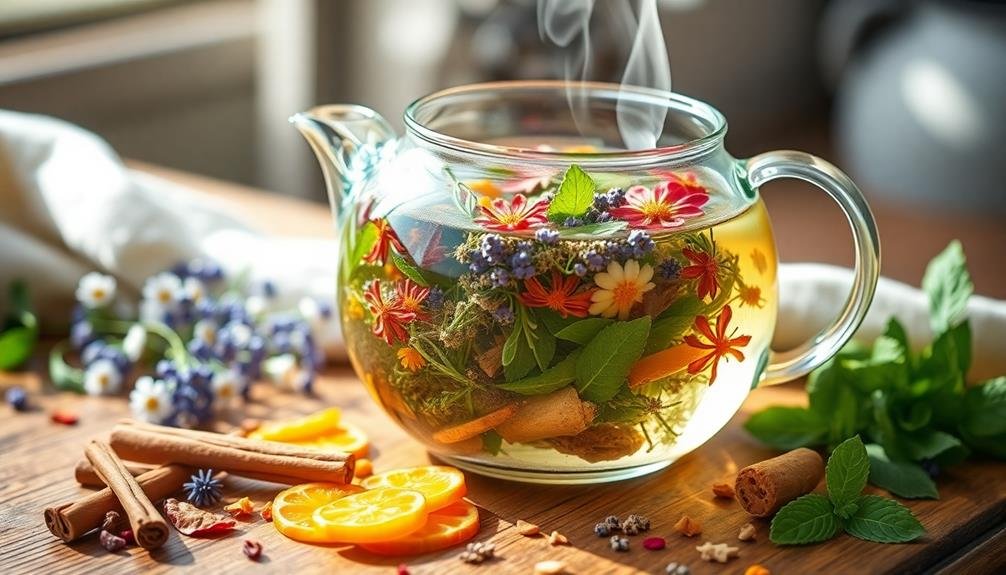
Once you've grasped the basics of balancing flavors and aromas, it's time to develop your own unique flavor profile for your herbal tea infusion.
Start by identifying the dominant flavor you want to feature. This could be a bold, spicy note like ginger or a delicate floral essence like lavender. Next, choose complementary ingredients that enhance your main flavor without overpowering it.
Consider the mouthfeel you're aiming for. Do you want a light, invigorating blend or a rich, full-bodied infusion? Select herbs and botanicals that contribute to your desired texture. For example, marshmallow root can add smoothness, while lemongrass provides a crisp finish.
Don't forget about color. Ingredients like hibiscus or butterfly pea flower can create visually striking infusions.
Experiment with different ratios and steeping times to achieve the perfect balance of flavor, aroma, and appearance.
Experimenting With Complementary Ingredients
Along with your primary flavor, complementary ingredients play an essential role in crafting a well-rounded herbal tea infusion. These secondary elements can enhance, balance, or add depth to your blend.
Start by identifying flavors that naturally pair well with your base ingredient. For example, if you're using chamomile as your primary herb, consider adding lemon balm for a citrusy note or lavender for a floral touch.
Don't be afraid to experiment with unexpected combinations. You might discover that a pinch of cinnamon adds warmth to a mint-based tea or that a few rose petals elevate a fruity blend.
When adding complementary ingredients, start with small amounts and adjust to taste. Remember that some herbs have stronger flavors than others, so use them sparingly.
Consider the visual appeal of your blend as well. Ingredients like calendula petals or blue cornflowers can add pops of color without greatly altering the taste.
As you experiment, keep notes on successful combinations and ratios. This will help you refine your blends and create a signature herbal tea infusion that's uniquely yours.
Measuring and Proportioning Ingredients
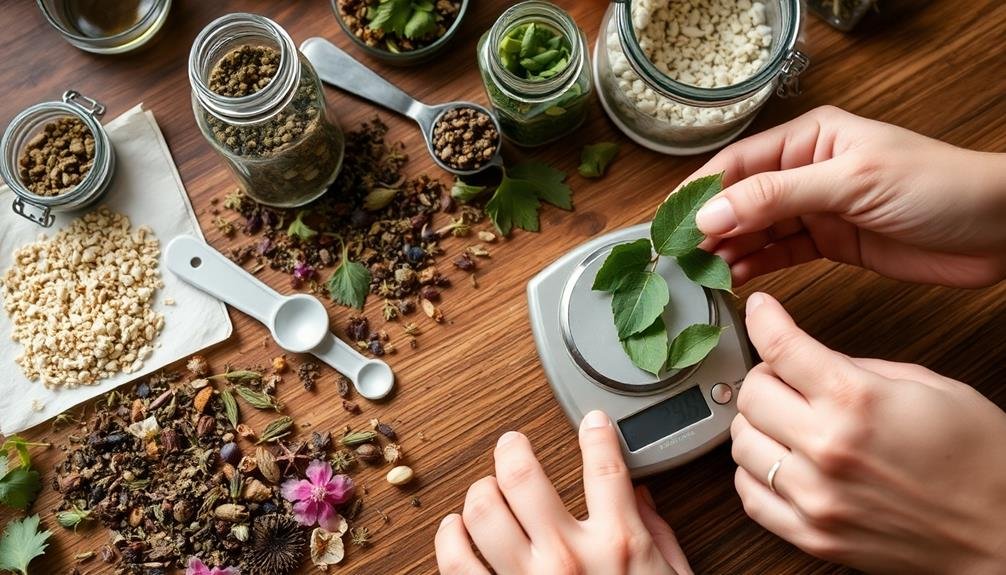
Precision is key when measuring and proportioning ingredients for your herbal tea infusions. Start by using a kitchen scale to weigh your herbs accurately. For loose leaf teas, aim for 1-2 grams of herbs per 8 ounces of water. If you're using fresh herbs, double the amount to account for their higher water content.
When blending multiple herbs, maintain a balanced ratio. Consider the strength and flavor profile of each ingredient. Typically, you'll want to use a larger proportion of milder base herbs (50-70%) and smaller amounts of stronger, more aromatic herbs (10-30%). Experiment with these ratios to find your preferred balance.
For consistency, create a master recipe with precise measurements. This allows you to replicate your blend easily. Don't forget to note steeping times, as different herbs require varying infusion periods. Delicate flowers may need only 3-5 minutes, while roots and barks might require 10-15 minutes.
Lastly, keep detailed records of your experiments. Note the measurements, proportions, and steeping times for each blend. This will help you refine your recipes and create your signature herbal tea infusions with confidence.
Proper Storage of Tea Blends
To keep your herbal tea blends fresh and flavorful, you'll want to store them properly.
Use airtight containers to protect your tea from moisture and odors that can degrade its quality.
Place these containers in a cool, dark location away from direct sunlight and heat sources to preserve the tea's aromatic compounds and extend its shelf life.
Airtight Containers
Proper storage is essential for maintaining the quality and flavor of your herbal tea blends. Airtight containers are your best allies in preserving the freshness and potency of your custom creations.
When choosing containers, opt for those made of glass, ceramic, or food-grade stainless steel. These materials won't impart unwanted flavors or odors to your tea blends.
Ensure the containers have tight-fitting lids or seals to prevent air and moisture from entering. Exposure to oxygen can lead to oxidation, diminishing the tea's flavor and aroma over time. Look for containers with rubber gaskets or silicone seals for an extra layer of protection.
Consider the size of your containers carefully. It's better to use multiple smaller containers rather than one large one, as this minimizes air exposure each time you open the container. Label your containers with the blend name and date of creation to keep track of freshness.
Store your airtight containers in a cool, dark place away from direct sunlight, heat sources, and strong odors. Avoid storing them near spices or in the refrigerator, as tea can absorb other flavors easily.
With proper storage in airtight containers, your herbal tea blends can maintain their quality for several months to a year.
Cool, Dark Location
Once you've chosen the right airtight containers, finding the ideal storage location is essential for preserving your herbal tea blends. You'll want to keep your teas in a cool, dark place away from direct sunlight, heat sources, and moisture. This helps maintain the flavor, aroma, and potency of your custom blends.
The perfect spot for storing your herbal teas could be a pantry, cupboard, or dedicated tea cabinet. Avoid placing them near the stove, sink, or windows, as these areas can expose your blends to temperature fluctuations and light. If you don't have a suitable indoor space, consider using a tea chest or box that you can keep in a cool room.
Here's a quick guide to help you choose the best storage location:
| Location | Pros | Cons |
|---|---|---|
| Pantry | Dark, consistent temp | May lack space |
| Tea cabinet | Organized, easy access | Requires dedicated space |
| Basement | Cool, dark environment | Potential humidity issues |
Steeping Techniques for Best Results
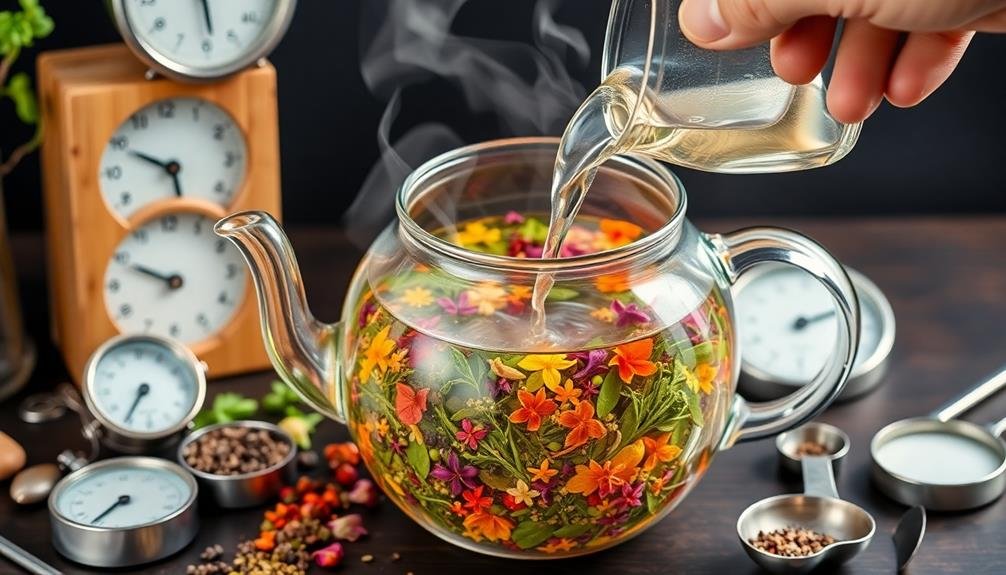
Mastering the art of steeping is essential for extracting the full flavor and benefits from your herbal tea. Start by using fresh, cold water and heating it to the appropriate temperature for your blend. Delicate herbs like chamomile or mint require water just below boiling (around 180°F), while heartier blends can withstand boiling water.
Measure your herbs carefully, using about 1 teaspoon of dried herbs or 1 tablespoon of fresh herbs per cup of water. Place the herbs in a tea infuser or directly in your teapot. Pour the hot water over the herbs and cover immediately to trap the essential oils.
Steep your tea for the right amount of time. Most herbal teas benefit from a 5-10 minute steeping period, but some may require longer. Experiment to find your preferred strength. Don't over-steep, as this can lead to a bitter taste.
After steeping, remove the herbs promptly. If you're using loose herbs, strain the tea into your cup. For a stronger brew, gently press the herbs against the strainer to release more flavor.
Enjoy your perfectly steeped herbal tea infusion immediately for the best taste and benefits.
Customizing Blends for Health Benefits
While mastering steeping techniques is important, creating custom herbal tea blends can release a world of health benefits tailored to your specific needs. Start by identifying your health goals, whether it's boosting immunity, improving digestion, or reducing stress.
Research herbs known for their medicinal properties and potential synergies when combined. Consider these popular herbs and their benefits:
- Chamomile: Calming and sleep-promoting
- Peppermint: Digestive aid and breath freshener
- Ginger: Anti-inflammatory and nausea relief
- Echinacea: Immune system booster
- Lemon balm: Stress reducer and mood enhancer
Experiment with different ratios to find your perfect blend. Start with a base herb that addresses your primary concern, then add complementary herbs for flavor and additional benefits.
Don't be afraid to mix dried fruits, spices, or even edible flowers for unique tastes and aromas. Keep a journal to track your blends and their effects. Note any improvements in your health or well-being.
Packaging and Gifting Your Creations
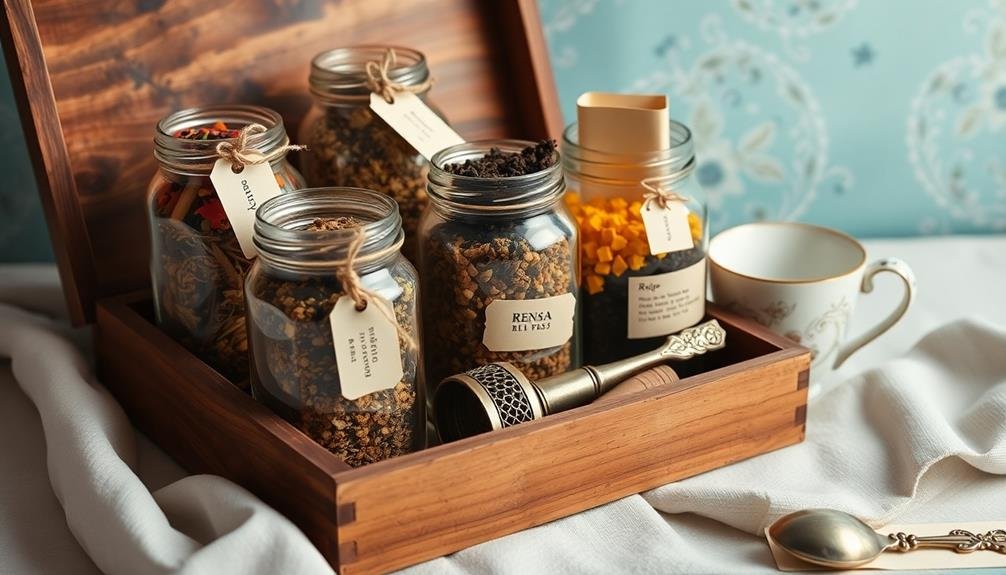
Your homemade herbal tea blends deserve beautiful packaging that reflects the care you've put into creating them. Start by selecting airtight containers to preserve the flavors and aromas of your teas. Glass jars with tight-fitting lids or tin canisters work well.
Label each container with the blend name, ingredients, and brewing instructions.
For gifting, consider creating a tea sampler set. Use small tins or sachets to package individual servings of different blends. Arrange these in a decorative box or basket, adding a handwritten note explaining each blend's benefits. You can also include tea accessories like a strainer or infuser.
Add a personal touch by designing custom labels or tags. Use kraft paper for a rustic look, or opt for elegant printed labels. Include brewing tips and suggested pairings to enhance the recipient's experience. For an eco-friendly option, use biodegradable packaging materials.
Consider seasonal packaging for holiday gifts. Use festive colors and add small ornaments or dried orange slices for winter blends. For summer teas, incorporate bright colors and floral elements.
Frequently Asked Questions
Can I Use Fresh Herbs Instead of Dried Ones in My Tea Blends?
Yes, you can use fresh herbs in your tea blends. They'll give a more vibrant flavor, but you'll need to use more. Keep in mind that fresh herbs have a shorter shelf life and may affect the tea's moisture content.
How Long Does a Homemade Herbal Tea Blend Typically Stay Fresh?
Your homemade herbal tea blend can stay fresh for 6-12 months if stored properly. Keep it in an airtight container away from light, heat, and moisture. You'll notice a decline in flavor and aroma when it's past its prime.
Are There Any Herbs That Should Never Be Combined in Tea Blends?
You should avoid combining certain herbs in tea blends. Don't mix St. John's Wort with antidepressants or birth control. Steer clear of blending licorice root with blood pressure medications. Always research potential interactions before creating your herbal tea combinations.
Can I Add Essential Oils to My Herbal Tea Blends for Extra Flavor?
You shouldn't add essential oils to your tea blends. They're not safe for internal use and can be toxic. Instead, use dried herbs or natural flavoring extracts specifically made for beverages to enhance your tea's taste.
What's the Best Way to Create Caffeine-Free Herbal Tea Blends?
To create caffeine-free herbal tea blends, you'll want to focus on using herbs, flowers, and fruits. Mix ingredients like chamomile, peppermint, rooibos, or hibiscus. Experiment with different combinations to find flavors you enjoy. Don't forget to balance tastes and aromas.
In Summary
You've now got the knowledge to craft your own unique herbal tea blends. Don't be afraid to experiment with different combinations and proportions. Remember to store your creations properly and steep them correctly for the best flavor. Whether you're blending for taste, health benefits, or both, you'll find joy in sipping your personalized infusions. Share your blends with friends and family, and keep refining your craft. Happy brewing!

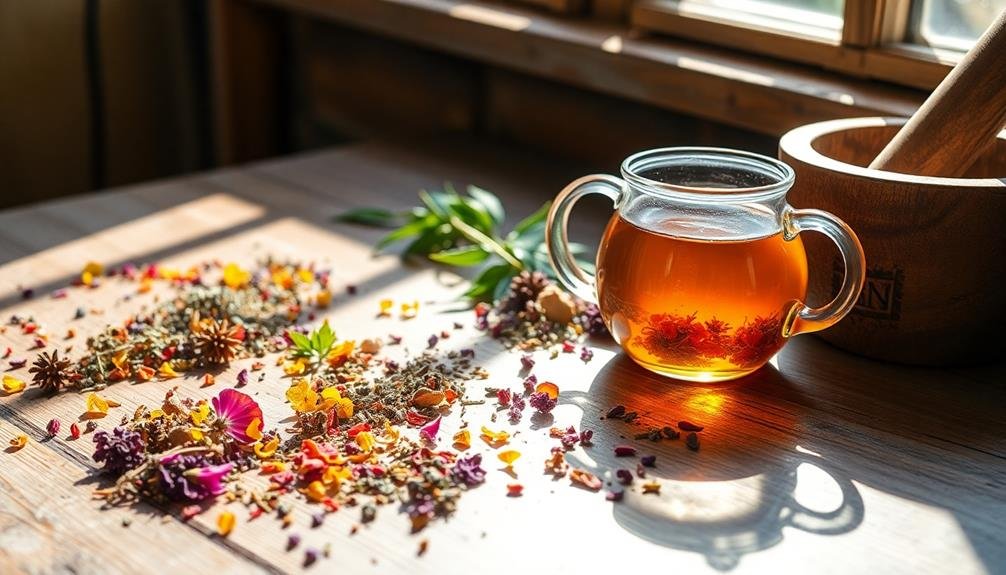



Leave a Reply